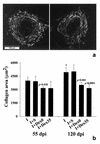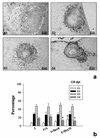Dexamethasone, a drug for attenuation of Schistosoma mansoni infection morbidity
- PMID: 12384355
- PMCID: PMC128711
- DOI: 10.1128/AAC.46.11.3490-3498.2002
Dexamethasone, a drug for attenuation of Schistosoma mansoni infection morbidity
Abstract
To investigate the possible use of immunomodulators as coadjuvants in the treatment of chronic schistosomiasis, the study described in the present report evaluated the effects of dexamethasone on several parameters which reflect disease severity and morbidity. Parasitological, immunological, and histological parameters were analyzed in animals treated from the first day of infection or after 35 days of infection. In both situations, dexamethasone had no effect on the parasite burden but altered the egg distribution in tissue, indicating that under the schedule used it did not interfere with the development of adult worms or oviposition. Treated mice showed a decrease in the number of eggs in hepatic tissue, reduced granuloma sizes, reduced levels of granuloma maturation, and reduced collagen contents. Dexamethasone-treated mice also had decreased gamma interferon, interleukin-12 (IL-12), and IL-4 levels in serum and increased IL-10 levels in serum. Taken together, these data suggested a decrease in the severity of murine schistosomiasis and point to dexamethasone as a convenient and promising coadjuvant agent in the therapy of this infection.
Figures





Similar articles
-
Immunological and parasitological parameters after treatment with dexamethasone in murine Schistosoma mansoni.Mem Inst Oswaldo Cruz. 2010 Sep;105(6):729-35. doi: 10.1590/s0074-02762010000600001. Mem Inst Oswaldo Cruz. 2010. PMID: 20944985
-
Dexamethasone treatment improves morphological and hematological parameters in chronic experimental schistosomiasis.Parasitol Res. 2004 Apr;92(6):478-83. doi: 10.1007/s00436-004-1078-8. Epub 2004 Mar 4. Parasitol Res. 2004. PMID: 14999468
-
Parasitological, Pathological, and Immunological Parameters Associated with Schistosoma mansoni Infection and Reinfection in BALB/c AND C57BL/6 Mice.J Parasitol. 2016 Jun;102(3):336-41. doi: 10.1645/14-664. Epub 2016 Feb 29. J Parasitol. 2016. PMID: 26928866
-
Regression of hepatic lesions after treatment of Schistosoma mansoni or Schistosoma japonicum infection in mice: a comparative study.Am J Trop Med Hyg. 1993 Jul;49(1):1-9. doi: 10.4269/ajtmh.1993.49.1. Am J Trop Med Hyg. 1993. PMID: 8352381
-
Lack of antigen-specific Th1 response alters granuloma formation and composition in Schistosoma mansoni-infected MyD88-/- mice.Eur J Immunol. 2005 Nov;35(11):3248-57. doi: 10.1002/eji.200526273. Eur J Immunol. 2005. PMID: 16276483
Cited by
-
Dexamethasone effects in the Strongyloides venezuelensis infection in a murine model.Am J Trop Med Hyg. 2011 Jun;84(6):957-66. doi: 10.4269/ajtmh.2011.10-0490. Am J Trop Med Hyg. 2011. PMID: 21633034 Free PMC article.
-
Descriptive study on risk of increased morbidity of schistosomiasis and graft loss after liver transplantation.Rev Soc Bras Med Trop. 2024 Jul 29;57:e00201. doi: 10.1590/0037-8682-0097-2024. eCollection 2024. Rev Soc Bras Med Trop. 2024. PMID: 39082515 Free PMC article.
-
Silymarin treatment reduces granuloma and hepatic fibrosis in experimental schistosomiasis.Parasitol Res. 2010 Nov;107(6):1429-34. doi: 10.1007/s00436-010-2014-8. Epub 2010 Aug 7. Parasitol Res. 2010. PMID: 20694562
-
Schistosomiasis Pulmonary Arterial Hypertension.Front Immunol. 2020 Dec 10;11:608883. doi: 10.3389/fimmu.2020.608883. eCollection 2020. Front Immunol. 2020. PMID: 33362796 Free PMC article. Review.
-
NF-κB signaling participates in both RANKL- and IL-4-induced macrophage fusion: receptor cross-talk leads to alterations in NF-κB pathways.J Immunol. 2011 Aug 15;187(4):1797-806. doi: 10.4049/jimmunol.1002628. Epub 2011 Jul 6. J Immunol. 2011. PMID: 21734075 Free PMC article.
References
-
- Agarwal, S. K., and G. D. Marshall, Jr. 2000. Role of CD28/B7 costimulation in the dexamethasone-induced suppression of IFN-gamma. J. Interferon Cytokine Res. 20:927-934. - PubMed
-
- Amiri, P., R. M. Locksley, T. G. Parslow, M. Sadick, E. Rector, D. Ritter, and J. H. McKerrow. 1992. Tumour necrosis factor alpha restores granulomas and induces parasite egg-laying in schistosome-infected SCID mice. Nature 356:604-607. - PubMed
-
- Andrade, Z. A. 1965. Hepatic schistosomiasis: morphological aspects, p. 228. In H. S. Popper (ed.), Progress in liver disease, ′vol. 2. Grune & Statton, New York, N.Y. - PubMed
-
- Bina, J. C., and A. Prata. 1983. Reversão da hepatoesplenomegalia pelo tratamento específico da esquistossomose. Rev. Soc. Bras. Med. Trop. 10:214-218.
-
- Bogliolo, L. 1954. Sobre o quadro anatômico do fígado na forma hepato-esplênica da esquistossomose mansônica. Hospital 45:283-306. - PubMed
MeSH terms
Substances
LinkOut - more resources
Full Text Sources

